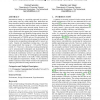Free Online Productivity Tools
i2Speak
i2Symbol
i2OCR
iTex2Img
iWeb2Print
iWeb2Shot
i2Type
iPdf2Split
iPdf2Merge
i2Bopomofo
i2Arabic
i2Style
i2Image
i2PDF
iLatex2Rtf
Sci2ools
104
Voted
IPSN
2009
Springer
2009
Springer
On hierarchical routing in wireless sensor networks
Hierarchical routing is a promising approach for point-topoint routing with very small routing state. While there are many theoretical analyses and high-level simulations demonstrating its benefits, there has been little work to evaluate it in a realistic wireless sensor network setting. Based on numerous proposed hierarchical routing infrastructures, we develop a framework that captures the common characteristics of the infrastructures and identifies design points where the infrastructures differ. We then evaluate the implementation of the framework in TOSSIM and on a 60-node testbed. We demonstrate that from the practical perspective hierarchical routing is also an appealing routing approach for sensor networks. Despite only logarithmic routing state, it can offer
Hierarchical Routing | Hierarchical Routing Infrastructures | IPSN 2009 | Routing | Sensor Networks |
Related Content
| Added | 20 May 2010 |
| Updated | 20 May 2010 |
| Type | Conference |
| Year | 2009 |
| Where | IPSN |
| Authors | Konrad Iwanicki, Maarten van Steen |
Comments (0)

